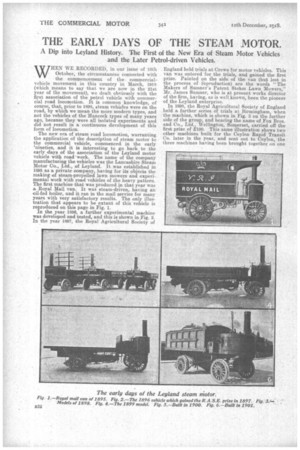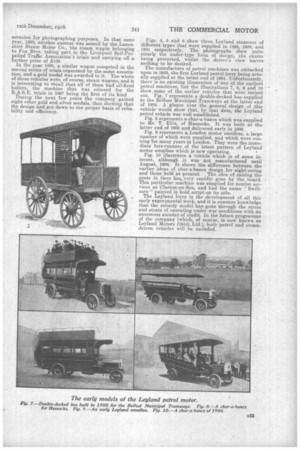THE EARLY DAYS OF THE STEAM MOTOR.
Page 12

Page 13

If you've noticed an error in this article please click here to report it so we can fix it.
A Dip into Leyland History. The First of the New Era of Steam Motor Vehicles and the Later Petrol-driven Vehicles.
WHEN WE RECORDED, in our issue of 10th October, the circumstances connected with the commencement of the commercialvehicle movement in this country in March, 1918 (which means to say that we are now in the 21st year of the movement), we dealt obviously with the first association of the petrol vehicle with commercial road locomotion. It is common knowledge, of course, that, prior to 1898, steam vehicles were on the road, by which we mean the more modern types, and not the vehicles of the Hancock types of many years ago, because they were all isolated experiments and did not result in a continuous development of this form of locomotion.
The new era of steam road locomotion, warranting the application of the description of steam motor to the commercial vehicle, commenced in the early 'nineties, and it is interesting to go back to the early days of the association of the Leyland motor vehicle with road 'work. The name of the company manufacturing the vehicles was the Lancashire Stearn Motor Co., Ltd., of Leyland. It was established in 1895 as a 'private company, having for its objects the making of steam-propelled lawn mowers and experimental work with road vehicles of the heavy pattern. The first machine that was produced in that year was a Royal Mail van. It was steam-driven, haviug an oil-fed boiler, and it ran in the mail service for many years with very satisfactory results. The only illustration that appears to be extant of this vehicle is reproduced on this page in Fig. 1.
In the year 1898, a further experimental machine was developed and tested, and this is shown in Fig. 2. In the year 1897, the Royal Agricultural Society of England held trials at Crowe for motor vehicles. This van was entered for the trials, and gained the first prize. Painted on the side of the van (but lost in the process of reproduction) are the words "The Makers of Sumner's Patent Steam Lawn Mowers," Mr. James Sumner, who is at present works director of the firm, having, as is well known, been the pioneer of the Leyland enterprise.
In 1898, the Royal Agricultural Society of England held a further series of trials at Birmingham, when the machine, which is shown in Fig. 3 on the further side of the group, and bearing the name of Fox Bros. and Co., Ltd, Wellington, Somerset, carried off the first prize of 2100. This same illustration shows two other machines built for the Ceylon Rapid Transit Co. later in the year, and sent out to Ceylon, the three machines having been brought together on one
occasion for photographing purposes. In that same year, 1898, another success was scored by the Lancashire Steam Motor Co., the steam wagon belonging to Fox Bros. taking part in the Liverpool Self-Propelled Traffic Association's trials and carrying off a further prize of 2100. In the year 1899, a similar wagon competed in the second series of trials organized by the same association, and a gold medal was awarded to it. The whole of these vehicles were, of course, steam wagons, and it is interesting to recall that all of them had oil-fired boilers, the machine that was entered for the R.A.S.E. trials in 1897 being the first of its kind . During the next few years the company gained eight other gold and silver medals, thus showing that the design had got. down to the proper basis of reliability and efficiency.
• Figs. 4, 5 and 6 show three Leyland steamers of different types that were supplied in 1899, 1900, and 1901 respectively. The photographs show quite clearly the under-type form of design, the chains being protected, whilst the driver's view leaves nothing to bedesired.
The manufacture of petrol machines was embarked upon in 1903, the first Leyland petrol lorry being actually supplied at the latter end of 1904. Unfortunately, there is no existing illustration of any of the earliest petrol machines, but the illustrations 7, 8, 9 and 10 show some of the earlier vehicles that were turned out. Fig. 7 represents a double-decked bus supplied to the Belfast Municipal Tramways at the latter end of 1905. A glance over the general design of this vehicle would show that, by that date, the Leyland petrol vehicle was well established.
Fig. 8 epresents a char-a-bancs which was supplied to Mr. T. Ellis, of Hassocks. It was built at the latter end of 1905 and delivered early in 1906.
Fig. 9 represents a, London motor omnibus, a large number of which were supplied, and which were running for many years in London. They were the immediate fore-runners of the latest pattern of Leyland motor omnibus which is now operating. Fig. 10 illustrates a vehicle which is of some interest, although it was not manufactured until August, 1906. It shows the difference between the earlier ideas of char-a-bancs design for sight-seeing and those held at present. The idea of raising the seats in tiers has, very rapidly gone by the board. This particular machine was supplied for tourist services at Clacton-on-Sea, and had the name " Swiftsure " painted in bold script on its side.
The Leyland..lorry is the development of all this early experimental-work, and it is common knowledge that the subsidy model hag gone through the stress and strain of operating under war conditions with an enormous amount of credit. In the future programme of the company (which, of course, is now known as Leyland Motors (1914), Ltd.), both petrol and steamdriven vehicles will be included.






















